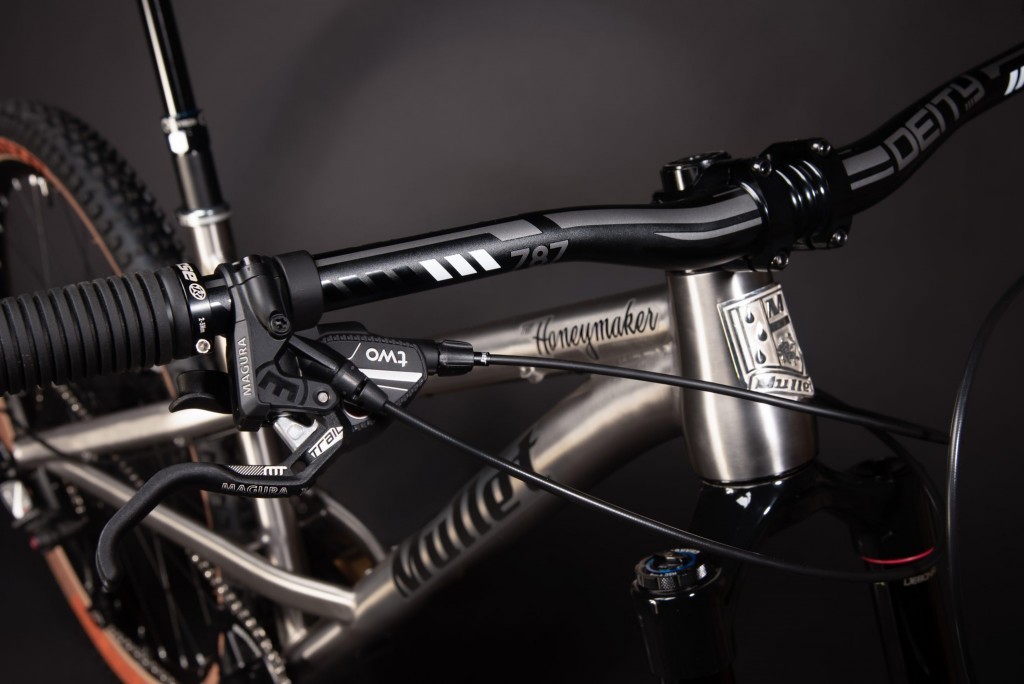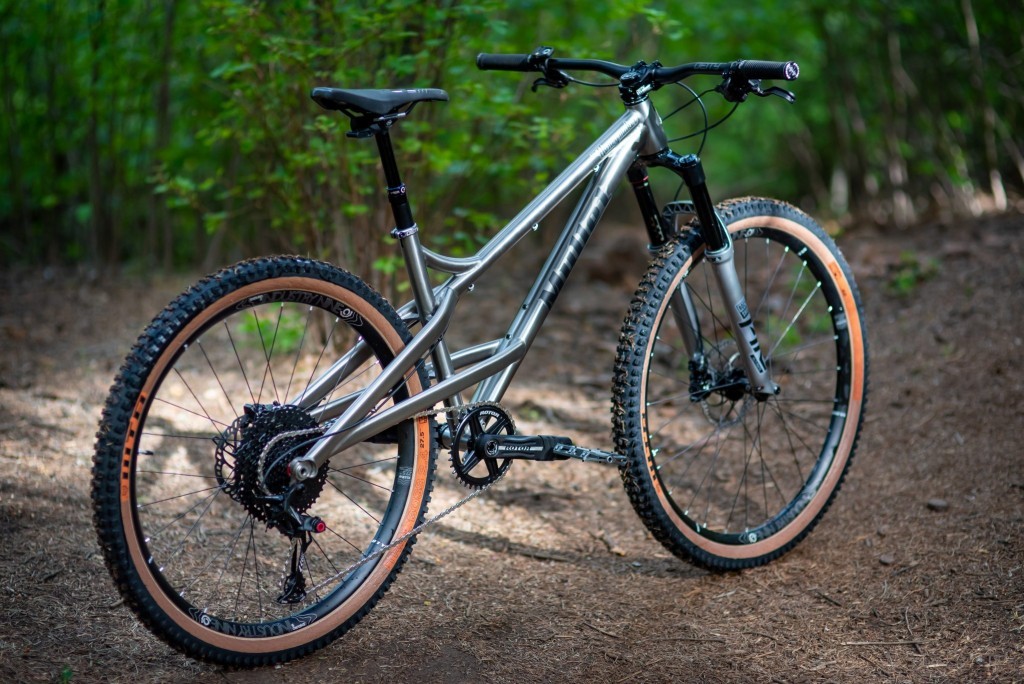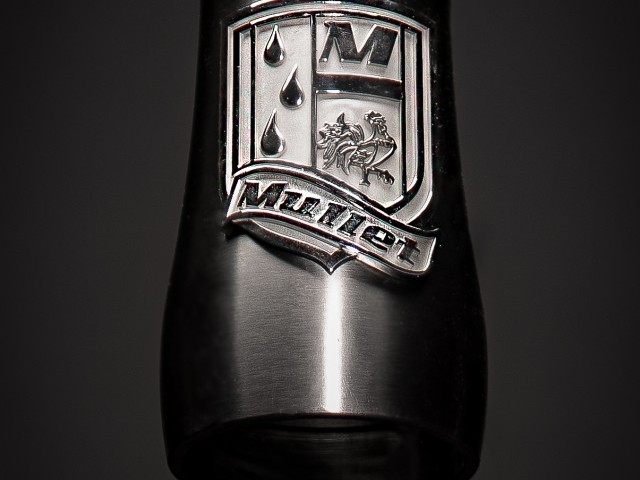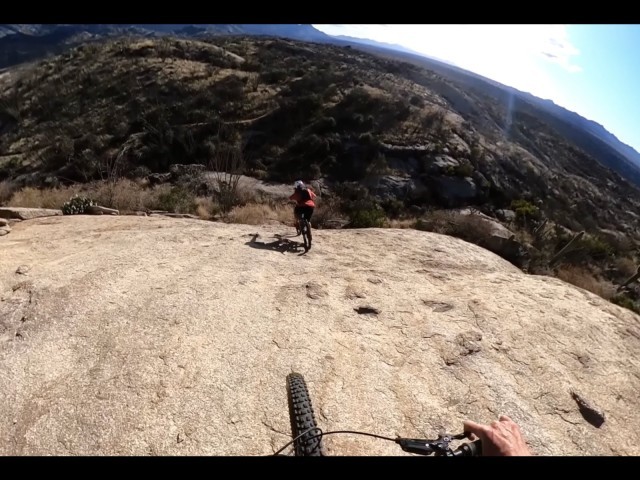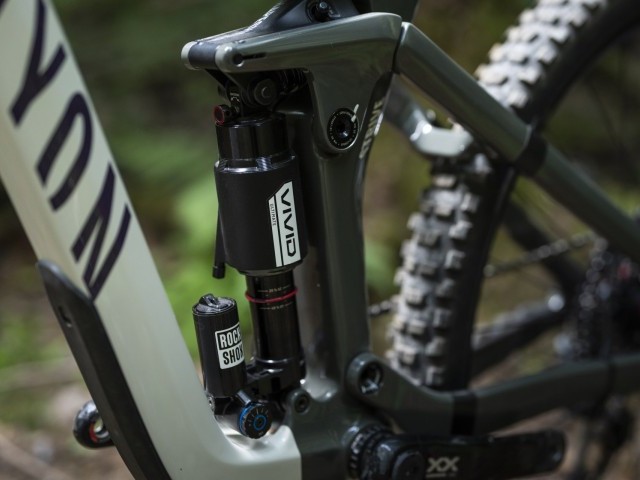
The Safety Bike is Dead – Introducing Mullet Cycles
Tue 25th Jun, 2019 @ 9:30 am
Near the US Olympic Training Center and at the base of Pikes Peak comes a new Bike company out of the “Ordinary”. Little did we know while everyone was talking about and testing a 29’’ front with a 27.5” rear wheel, somebody has been working on this platform since 2012. The recent UCI rules change opened everyone’s eyes to running the “Mullet platform” and these guys have optimized it.
Michael Vidovich out of Manitou Springs, Colorado is one of those guys. Some know him as an advanced moto rider, others know him as an ace mechanic for motorcycles, suspension, mountain bikes and aircrafts. People on the School Board know him as the VP of the Automotive Institute of Science and Technology. But many may not know him as the guy who brought the “Mixer” model to a small American fabricator.
In 2012 Mike V., opened up his own bike shop called Timberline Cycles in Colorado Springs. He managed a number of bike shops and wanted to bring in obscure brands that were doing things differently. To be more specific, he wanted to carry every full suspension linkage in order to learn their advantages and disadvantages. With a “RaceTech Suspension Certification” and being a demanding rider himself, carrying these brands was a major perk of owning a bike shop. He was also the exclusive dealer for a Spanish Motorbike company called GasGas.
It was in early 2013 and with the introduction of 27.5’’ wheel that a serious light bulb went off. He lined up a 29’’ wheel and a 27.5’’ wheel next to a KTM 250XC he was repairing. They shared an almost identical outer wheel circumference front/rear. Many sleepless nights followed and Mike V. was working on geometry that would work for a Mountain Bike. Once he dialed in his data points he reached out to a number of bike companies to see if they’d be interested in making his mixed wheel design. None of them were, many said he was crazy. Luckily, the last company agreed to manufacture them; only if Mike would purchase an agreed amount that would make it worth while for them. Based on the agreement, the model would be exclusively sold through Mike’s shop, Timberline Cycles. Mike began improving the geometry when suddenly the rug was pulled out from him and the contract was broken. Putting all his eggs into one basket meant he was no longer carrying any other brands. As a result, he had to close Timberline Cycles. Feeling deflated and embarrassed for himself and his family, in comes Miles Schwartz. Miles has been in the mtb community since the 90’s and is the owner of a small cycling accessory company called Mile Wide.
As Mike V. was closing his doors for good, Miles came in to drop off free shwag and talk tech since he heard of Mike V. for building radical bikes. Miles noticed an empty shop and immediately thought he knew the story. However, Mike’s story was different. He wasn’t burned by the internet. It was his supplier that did him in. It was painful for Mike to recite the whole story. However, Mike was certain that if he’d get Miles to swing a leg over his bike, it’d change the way Miles thought about Mountain Bikes forever. Being a skeptic from New York, Miles believes most things are smoke and mirrors until there’s proof in the pudding. After throwing down some KOM’s and PR’s on trails, though very impressed, Miles was still not convinced. So he took out the steed he’s ridden everywhere- Pisgah, Windrock, Angel Fire, Trestle and Whistler. With considerable effort, Miles was certain he would beat every time posted on Mike’s machine. However, as the old West saying goes, “There’s a big difference between the Ox and the Whippletree”. After dozens of sanity checks, he was met with slower times. Miles then realized what Mike created wasn’t a bike; it was a “Mullet”. The platform felt different, special, and advanced; Unbecoming to the mountain bike wheel size debate. Despite the “Ordinary” looks, it performed better then any symmetrical wheel platform (Safety Bike) was capable of.
Mixing wheel diameters enabled Mike V. to tune Force Vectors and Scrub Radiuses through optimized geometry. Wheel diameter manipulation has been adopted in almost every industry devoted to “Speed” except the bicycle.
We have to start at the beginning. And when we say beginning, I mean the first pedal bike known as the “Ordinary”, “Big Wheel” or the most popular nicknamed, the “Penny Farthington”. This name came from British currency, the Penny coin being much larger with a Farthington coin trailing behind. They were very unsafe. However, during this period it was thought that by having a larger front wheel you could go faster. They were right to a point. But those pedals were fixed and if you had to come to a sudden stop, you’d fly soaring 8 feet into the air. They were mostly suited for tall, slender men.
During the late 1800’s, there was a powerful women’s’ movement taking place. What first started as trading in their corsets for “bloomers”, begat the ultimate freedom of riding bicycles. Since women weren’t allowed to operate motorized-vehicles, the bicycle was also a revolutionary way for transportation. Roads weren’t built for cars yet and with such large demand, there needed to be a “safer” bike for the general public. In 1885, John Starley came out with the “Rover Safety Bicycle”. Mr. Starley designed his bicycle using two wheels that shared an equal diameter of 26’’ Front and Rear.
His Safety Bike design enabled bicycles to be lower to the ground, more stable and easier to mass-produce then the “Penny” bike. With a chain, it was capable of having different gears or “speeds”. The Modern Bicycle and Mountain Bike are still based on this “Safety Platform”.
Bikes were evolving to go faster on the road. The Tour De France was and still is the most popular bike race in the World. Skinny tires, big wagon wheels and heavy steel to help brake the wind was the trend. Other then updating components and composites; the modern road bike hasn’t changed since the 1940’s. Motorcycles have evolved COMPLETELY since around the same time.
With the introduction of the “Safety Bike”, many nations were looking for an “Iron Horse”. A vehicle a soldier could use to deliver military strategies without getting shot down (a horse was an easier target then a soldier). During WWI, every Nation had supplied bicycles to their infantry soldiers. Since the bicycle was so successful in WWI, Nations sought to create a motorized bicycle during WWII. From the combustion motor and clever ingenuity the first motorcycles were born out of necessity, on a “Safety Bike”. After the wars seized, soldiers came home with these early Motorcycles and began off road racing in Europe in what they’d call “Scrambling”. Since humans have a need for speed and competition, innovation began to make Motorcycles faster, safer and more stable from 5-150mph. Since we’re focusing on Dirt Bikes, it wasn’t until the 1970’s (30 years later) for the industry to establish a wheel standard of 21’’ front to a 18-19’’ rear. Still to this day, it’s the most common wheel platform found on dirt bikes.
By optimizing “pitch”, it enabled the front wheel to travel over obstacles with limited force of the rear wheel pushing forward. By having a smaller rear wheel, going over the handlebars also became less common. Think of a boat getting on plain having a much easier time going over large waves then if it’s up on plain (flat, equal, symmetrical). When a boat is on a level plane it smashes through the waves instead of traveling over them. The smaller rear wheel also enables the bike to turn with less effort by reducing its turn-in radius (which results in less forces pushing on the front wheel). This is how trailers with smaller rear wheels are able complete tight turning radiuses. Bicycles with symmetrical wheels become hard to turn around 25mph, unless head tube angles are extremely slacked. Then the bike has trouble handling at slower speeds. This is why we see different bicycle models for different speeds. An XC bike handles well at low speed, Enduro at moderate speed and a Downhill bike at high speeds. Mullet Cycles claims their Honeymaker Hardtail is a supreme handler of all those speeds. The Peacemaker 160mm full suspension will be even more lethal in the right hands.
Why has it taken so long for us to get to this point?
Like the Dirt Bike industry, the Mountain Bike industry isn’t that far off on the timeline. It took Dirt Bikes around 30 years to find their standard wheel platform. Mountain Bikes first appeared in the late 70’s with radical guys like Mike V. taking their beach cruisers, “Clunkers”, up into the California Mountains and bombing down. First we had “Breezer” bikes then bicycle manufactures from the 80’s, such as Panasonic and Shogun, took wind of this and began putting knobby tires and smaller wheels on their road bikes. Other then those enhancements, they were road bikes and people accomplished incredible things on them. The first major innovation came in the early 90’s, Forks and Rear Shocks. Forks used rubber elastomers and Shocks used a spring, which needed linkages. 30 years later and suspension manufactures have come a long way. However, 30 years later and bike companies are still claiming they came out with the best linkage for pedal bob, progression, small bump absorption, anti-squat etc. Basically the same selling points the suspension manufactures tell us their product already does.
So what’s going on here?
Without giving too much away about Mullets full suspension design, MTB companies have focused all their efforts on designing advanced linkages and geometry- Only so Safety Bikes can handle better off-road. It’s time to focus on the proven dirt bike platform.
It’s a New and Great Time to be a Mountain Biker
Mullet Cycles is proud to introduce their 140mm Honeymaker Titanium Hardtail. You can buy it now for $3,999 Complete or $1,599 for the Frameset. You can ask your Local Bike Shop if they’ll carry Mullet Cycles since their main focus will be set on Local Bike Shops. For now, you can purchase off their website http://www.MulletCycles.com
They have plans to release a 160mm Full Suspension, a 120mm Full and the Gravel bike (650b/700C) this summer. The Haymaker DH bike is said to be ready by 2020.


